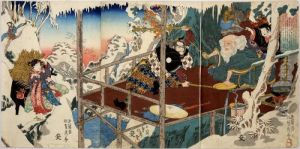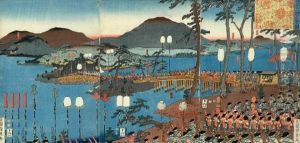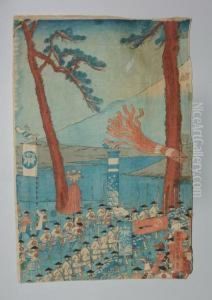Gountei Sadahide Paintings
Gountei Sadahide, born in 1807 and passing away between 1878 and 1879, was a distinguished Japanese ukiyo-e artist known for his woodblock prints. He was particularly active during the late Edo and early Meiji periods, a time of significant transition in Japan's history, marked by the opening of Japan to the West and the end of the feudal shogunate system. Sadahide is often remembered for his detailed landscapes, historical scenes, and depictions of foreigners, which reflected the changing times of his country.
Sadahide was originally named Hashimoto Kenjirō. He became a pupil of the famous Utagawa Kunisada, who was one of the leading figures in the ukiyo-e genre during the 19th century. Under Kunisada's guidance, Sadahide adopted the name Gountei Sadahide. His works are characterized by their meticulous detail and vibrant use of color, attributes that made his prints highly popular among the Japanese public and collectors.
One of Sadahide's most notable contributions to the ukiyo-e genre was his involvement in the creation of 'Yokohama-e,' a type of print that depicted scenes of Yokohama and its foreign residents and visitors. These prints were produced following the opening of Yokohama port to American and European ships in 1859, an event that marked the beginning of Japan's integration into the global community. Sadahide's Yokohama-e are valued not only for their artistic merit but also as historical documents that capture a pivotal moment in Japan's journey towards modernization.
Throughout his career, Sadahide also produced maps and illustrated books, showcasing his versatile talent and keen eye for detail. His works provide a fascinating glimpse into the cultural and societal shifts occurring in Japan during the 19th century. Despite the challenges posed by the rapidly changing times, Sadahide's art remained influential, and he is celebrated today as a master of the ukiyo-e tradition whose works continue to captivate audiences around the world.


